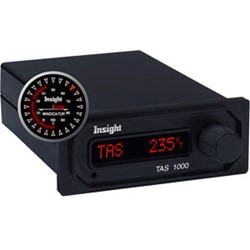THE ESSENTIAL COMPONENT FOR YOUR GPS SYSTEM
Today’s modern avionics integrate many functions with your GPS, but standard installations leave many important features untapped. The TAS 1000 Multi-Function Data Source was specifically designed to supply all the information needed to fill in the missing pieces of your GPS or MFD display in real-time.In addition to it’s role as an important partner in your GPS system, the TAS 1000 MFDS is a versatile multi-function instrument. Configured by the pilot to meet exact needs, TAS 1000 is simple and user-friendly.
Everyone underestimates the importance of having an instantaneous display of wind speed and direction until they see it in action. Once pilots have experienced flying with the WindicatorTM, they won’t fly without it!
The simple dedicated fuel computer is now obsolete. The TAS 1000 MFDS offers extensive fuel management information, and is user configured using a rotary switch for fuel setting. TAS makes it easier and faster to initialize, than other fuel computers.
The TAS has the best, built-in Altitude Alerter on the market. Unlike other add-on alerters that depend on the coarse resolution of an altitude encoder, the TAS uses baro-corrected altitude derived directly from static pressure.
Improve safety and precision of your IFR procedures with TAS 1000’s altitude alerter.
Modern GPS systems require a baro setting input. The TAS 1000 MFDS can read baro setting from many types of altimeters, incorporate it into its calculations, and transmit to most GPS’s. The pilot just sets the altimeter and everything else is automatically updated.
Among the many features that are unique, the TAS 1000 MFDS displays Gradient. The rate of climb or decent is expressed in feet per nautical mile. Safe IFR arrival and departure procedures depend on minimum gradients for safe obstacle clearance. Most pilots have little practical experience gauging gradient. It changes with airplane configuration, engine performance, altitude, temperature, and wind. Gradient becomes critically important when an engine fails. The TAS allows you to maximize glide gradient in a single. In a twin, on one engine, blue line speed rarely offers best performance. However, the TAS display in feet per nautical mile is a direct measure of climb performance under all conditions. Knowing your gradient performance in an emergency can make a critical difference.
When an aircraft is in motion the OAT probe reports a temperature higher than the surrounding air. The faster the indicated airspeed, the greater the error. That is why pilots are taught icing can occur in above freezing temperatures. Of course it can’t. The TAS 1000 MFDS computes Static Air Temperature, that represents the actual temperature of water droplets in the cloud. When you use SAT, your icing decisions will be a lot clearer.
Does your airplane meet the book? Pilot Operating Handbook tables require temperature expressed as a deviation from a standard that changes with altitude. The TAS computes the required ISA temperature from altitude, airspeed, and outside air temperature. Erroneous temperature data will destroy the accuracy of any performance calculation. The TAS provides the correct value.
Inexpensive blind encoders are the most common causes of altitude reporting problems. The TAS 1000 MFDS’s accurate altitude information can be sent to your transponder and GPS. It is aviation’s most precise encoder.
Safe flight in IFR conditions demands precise altitude, air speed and vertical speed information. With near perfect accuracy, the TAS 1000 will serve as a standby altimeter, air speed and IVSI, independently of the primary instruments.
Helicopter, seaplane, EMS, and bush pilots who land off airport can now have the advantage of real-time, right-now wind information.
Floatplanes offer a challenge like no other airplane. Every landing is different. The pilot alone must assess the wind conditions and decide where to land. The Windicator’sTM accurate real- time wind information ensures landing directly into the wind on every approach. Even as the winds change below the tree line or near rugged terrain, the WindicatorTM keeps you informed. For floatplane operations, it’s magic.
Wind shear is invisible and takes its victims by surprise. Sudden and significant loss of airspeed can bring even the biggest airplane down. Knowledge of real-time wind information on short final can prevent wind shear accidents. When the winds reported by the tower and the WindicatorTM differ, you know there will be a wind shift during the approach. Work the winds to your best advantage on every flight. You’ll save time and money when you do. Pick the best tail wind or the least head wind and easily decide on best speed or range. The dynamic display of actual fuel efficiency responds immediately to changes in conditions so you can assess the effect of winds even in climb.
Jet aircraft flight parameters based on current conditions are immediately available on the TAS display. You need not refer to charts, tables or graphs or calculate anything by hand. Just turn the knob to display V1, Vr, V2, Vref, etc for current conditions. This information is custom tailored for your specific aircraft.
- Pressure Altitude, Barometric Setting
- Density Altitude, Density Altitude Difference
- Indicated Air Speed, True Air Speed, Ground Speed
- MACH Number
- IVSI
- Climb/Descent Gradient
- Total Air Temperature, Static Air Temperature, ISA Temperature
- Battery Voltage
- Altitude Alerts, Overspeed Warning
- Total Fuel Flow, Total Fuel Used, Total Fuel Remaining
- Left Fuel Flow, Left Fuel Used
- Right Fuel Flow, Right Fuel Used
- Fuel Flow Left/Right
- Fuel Efficiency
- Wind Speed, Direction, Component, Correction Angle
- Take-Off Decision Speed, Distance, Power Setting
- Rotation Speed, Climb Speed, Approach Speed
- Landing Distance
- Current Aircraft Weight
- Static Error Correction


